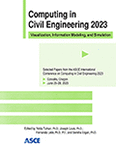Reality and BIM Model-Driven Near-Miss Alerting Framework for Construction Equipment Using AR Interface
Publication: Computing in Civil Engineering 2023
ABSTRACT
Augmented reality (AR) has been proven to be an effective tool for providing instructive information to users. This characteristic of AR could be used to alert construction workers to avoid potential safety issues such as struck-by accidents and near-misses. Therefore, this paper proposes a near-miss alerting framework for construction equipment that utilizes an AR interface driven by reality and BIM models. The framework includes the 3D virtual environment generation, AR real-time localization and object interaction, near-miss detection, and AR visualization. We developed struck-by incident scenarios with construction equipment and BIM models in a virtual environment that could be used with AR devices in the real world. The AR system includes a location-based near-miss detection method that detects moving objects around the user and alerts them through the AR interface. The system is tested in real-world settings, and the preliminary results show that AR could potentially enhance situational awareness for construction workers.
Get full access to this article
View all available purchase options and get full access to this chapter.
REFERENCES
Albert, A., Hallowell, M. R., Kleiner, B., Chen, A., and Golparvar-Fard, M. (2014). “Enhancing construction hazard recognition with high-fidelity augmented virtuality.” Journal of Construction Engineering and Management, 140(7), 04014024.
Behzadan, A. H., and Kamat, V. R. (2013). “Enabling discovery‐based learning in construction using telepresent augmented reality.” Automation in Construction, 33, 3–10.
BLS. (2022). A look at workplace deaths, injuries, and illnesses on Workers’ Memorial Day. US Department of Labor.
Cambraia, F. B., Saurin, T. A., and Formoso, C. T. (2010). “Identification, analysis and dissemination of information on near misses: A case study in the construction industry.” Safety Science, 48(1), 91–99.
Chi, H.-L., Kang, S.-C., and Wang, X. (2013). “Research trends and opportunities of augmented reality applications in architecture, engineering, and construction.” Automation in construction, 33, 116–122.
Choudhry, R. M., and Fang, D. (2008). “Why operatives engage in unsafe work behavior: Investigating factors on construction sites.” Safety science, 46(4), 566–584.
Golovina, O., Teizer, J., and Pradhananga, N. (2016). “Heat map generation for predictive safety planning: Preventing struck-by and near miss interactions between workers-on-foot and construction equipment.” Automation in construction, 71, 99–115.
Haas, E. J., and Yorio, P. L. (2019). “The role of risk avoidance and locus of control in workers’ near miss experiences: Implications for improving safety management systems.” Journal of loss prevention in the process industries, 59, 91–99.
Hasan, R., and Hasan, R. (2022). “Pedestrian safety using the Internet of Things and sensors: Issues, challenges, and open problems.” Future Generation Computer Systems.
Jones, S., Kirchsteiger, C., and Bjerke, W. (1999). “The importance of near miss reporting to further improve safety performance.” Journal of Loss Prevention in the process industries, 12(1), 59–67.
Kim, H., Kim, K., and Kim, H. (2016). “Vision-based object-centric safety assessment using fuzzy inference: Monitoring struck-by accidents with moving objects.” Journal of Computing in Civil Engineering, 30(4), 04015075.
Kim, K., Kim, H., and Kim, H. (2017). “Image-based construction hazard avoidance system using augmented reality in wearable device.” Automation in construction, 83, 390–403.
Li, X., Yi, W., Chi, H.-L., Wang, X., and Chan, A. P. (2018). “A critical review of virtual and augmented reality (VR/AR) applications in construction safety.” Automation in Construction, 86, 150–162.
OSHA. (2021). “Near-Miss Incident Report Form.” <https://www.osha.gov/sites/default/files/2021-07/Template%20for%20Near%20Miss%20Report%20Form.pdf>. (Mar.3, 2023).
Salmane, H., Khoudour, L., and Ruichek, Y. (2015). “A video-analysis-based railway–road safety system for detecting hazard situations at level crossings.” IEEE transactions on intelligent transportation systems, 16(2), 596–609.
Shen, X., and Marks, E. (2016). “Near-miss information visualization tool in BIM for construction safety.” Journal of construction engineering and management, 142(4), 04015100.
Teizer, J., Allread, B. S., and Mantripragada, U. (2010). “Automating the blind spot measurement of construction equipment.” Automation in Construction, 19(4), 491–501.
Winkler, M., Perlman, Y., and Westreich, S. (2019). “Reporting near-miss safety events: Impacts and decision-making analysis.” Safety science, 117, 365–374.
Zhang, Z., Trivedi, C., and Liu, X. (2018). “Automated detection of grade-crossing-trespassing near misses based on computer vision analysis of surveillance video data.” Safety science, 110, 276–285.
Zhou, C., Chen, R., Jiang, S., Zhou, Y., Ding, L., Skibniewski, M. J., and Lin, X. (2019). “Human dynamics in near-miss accidents resulting from unsafe behavior of construction workers.” Physica A: Statistical Mechanics and its Applications, 530, 121495.
Zhou, Z., Li, C., Mi, C., and Qian, L. (2019). “Exploring the potential use of near-miss information to improve construction safety performance.” Sustainability, 11(5), 1264.
Information & Authors
Information
Published In
History
Published online: Jan 25, 2024
ASCE Technical Topics:
- Business management
- Computer vision and image processing
- Construction engineering
- Construction equipment
- Construction management
- Decision making
- Decision support systems
- Employment
- Engineering fundamentals
- Equipment and machinery
- Labor
- Methodology (by type)
- Models (by type)
- Occupational safety
- Personnel management
- Practice and Profession
- Public administration
- Public health and safety
- Safety
- Simulation models
Authors
Metrics & Citations
Metrics
Citations
Download citation
If you have the appropriate software installed, you can download article citation data to the citation manager of your choice. Simply select your manager software from the list below and click Download.
